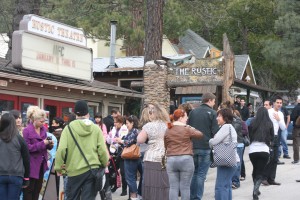
Beginning Monday, April 16, the Rustic Theatre will shutter for four days to convert from long-dominant 35 millimeter to state-of-the-art digital projection. The era of reels of film is ending. For movie houses that cannot afford the upgrade to digital, it is also the end. Conversion is forcing the closure of nearly 1,000 smaller movie theaters, representing about 10,000 screens, or 20 percent of all movie theaters in North America. These estimates come from the National Association of Theatre Owners (NATO).
The change to digital projection costs between $60,000 to $90,000 per screen, which is simply too large a hurdle for many small theater owners to overcome. “Convert or die,” said John Fithian, CEO and president of NATO, of the mandatory change, summing up the situation facing small operators.
Idyllwild will not be among those small cinemas that will slowly fade to black and die. On Friday, April 20, the Rustic reopens with its new digital projection system.
Shane Stewart, Rustic Theatre owner and operator, said he decided to make the investment to guarantee a movie house would remain on the Hill and to enhance and perpetuate the Idyllwild International Film Festival as a quality venue for independent filmmakers. Stewart has already installed an upgraded state-of-the-art Dolby digital sound system.
With new digital projection and sound, the Idyllwild film festival will have a screening system that few festival venues have. “We’ll be providing the same quality screening experience as Sundance, Toronto and Telluride,” Stewart said.
He also noted that it is fortunate the Rustic is as old as it is, with grandfathered distribution licenses with major studios that go back for decades. Stewart said it would cost over $1 million to construct a new movie house on the Hill with the kind of equipment and screening abilities studios are now requiring, and to acquire the necessary distribution licenses for first-run films.
“Given our population, with that kind of $1 million-plus investment, the numbers would never make sense,” Stewart said. “If this theater had disappeared, we would never have been able to get back [major film] distribution rights or have a new first-run theater.”
Long the standard throughout the world, the distribution and screening of movies filmed in 35 millimeter is ending, forever curtaining an era associated with marketing terms like Technicolor, Cinemascope, Cinerama and Academy Award format. By the end of 2013, Fithian said, celluloid prints of new movies from the major studios will no longer be available in the United States.
From now on, all major films will be distributed in digital format, one that is less costly for studios to distribute (saving studios an estimated $1 billion annually in printmaking fees and shipping costs) and one that results in markedly superior on-screen visual quality.
“This current movie, ‘The Hunger Games,’ is the last that will be shown in 35 millimeter,” Stewart said. He talked about what flexibility and dividends the change provides for the Rustic, its audiences and for the movie studios.
Beginning Friday, April 27, Rustic patrons, in addition to experiencing the highest quality visuals and sound, will benefit from a new policy of two first-run movies every week. “Each movie will run for two weeks, but alternating the week they change,” Stewart said. “That will enable us to screen more PG, first-run fare in the afternoon and studio blockbusters in the evening.
“In the past, people would complain to me why I didn’t show a particular first-run film,” Stewart said. “They didn’t realize that it costs a studio about $2,000 to make a print. And if they [the studios] had to decide where to send particular prints, a small theater in the mountains might not come in first. But now, with digital, it’s a thumb drive, far less costly to create and distribute.”
Stewart also mentioned he has little flexibility in setting ticket prices. “Contrary to popular belief, theaters make almost no money from ticket sales,” he said. “Studios make the ticket pricing. We, as most theaters do, make our money from concessions.”









